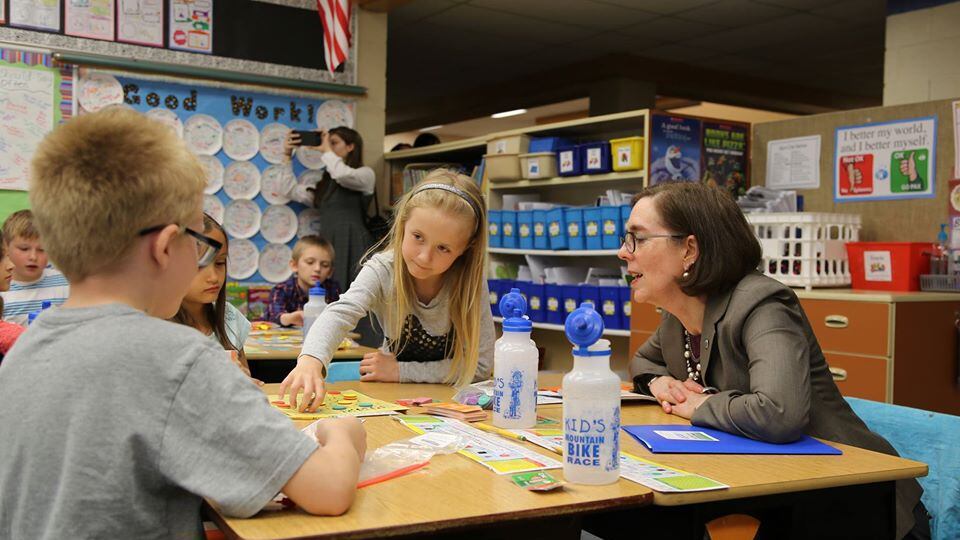Gov. Kate Brown today announced that Oregon's public school students will not return to brick-and-mortar buildings in the 2019-2020 school year because of the novel coronavirus.
"The best thing we can do is give everyone certainty by announcing we're closing for the rest of the school year," Brown said in a 1 pm press conference today.
Brown noted the decision was "first and foremost about safety," noting that it is impossible to practice social distance in school buildings.
"I know this is certainly not what anyone was hoping for," Brown added.
Julia Brim-Edwards, a member of the Portland Public School Board, says Brown's decision was the right one.
"This is difficult and disappointing news for students and their families, but Governor Brown made the right call from a health and safety standpoint and a decision that will protect our educators, students and the broader community," Brim-Edwards said in a statement.
"Our buildings will be closed, but learning can and will continue. I believe our students are resilient, and our educators are adaptive and innovative. For our students, school leaders including board members don't have an option of saying that we can't shift to a new model of learning. We need to identify and remove barriers to our students and educators who may be challenged by a distance learning model, and provide them the support to be successful."
Jim Green, the executive director of the Oregon School Boards Association, said Brown's decision was inevitable.
"It has appeared for some time this day was coming, but it's a difficult day all the same," Green said in a statement. "It's sad to think of families unable to experience the graduation moment celebrating years of hard work by students. It's sad to think of empty classrooms, further disruptions in learning, and knowing that some students' needs will be unmet. But these are unprecedented times, and we support the governor's decision in the interest of protecting public health."
Students will now receive instruction remotely through distance-learning lessons that the state's 197 districts are racing to put in place.
In concert with Brown's announcement, the Oregon Department of Education released new guidance on distance learning, which can be found here.
Implementing distance learning presents a host of challenges: some students lack broadband access and computers or tablets on which to receive their lessons; some students have special needs that that require individualized instruction; few teachers are trained on how to provide distance learning; and, the curricula they teach were not designed for remote instruction.
From a legal perspective, the federal Individuals With Disabilities Education Act (IDEA) requires all school districts to provide a "free appropriate education to children with disabilities." The Oregon Department of Education has cautioned districts to keep that law in mind when switching to distance learning.
"All students in the school or district have full access to the learning, the educators, and required materials (including technology)," ODE said to districts after Brown initially closed schools March 12.
That focus on equity meant that Oregon districts could offer supplemental materials to students but not switch to full online instruction unless every student could be fully served.
Federal Education Secretary Betsy DeVos seemed to back away from strict observance of the law, however, in communications she sent out around the same time.
"Nothing issued by this Department should in any way prevent any school from offering educational programs through distance instruction," DeVos said in a March 21 statement. "We need schools to educate all students out of principle, rather than educate no students out of fear."
Beyond those challenges are plenty of other questions: How will teachers take attendance or ensure students are making adequate progress for promotion or graduation? What about the wide variation between districts' ability to provide distance learning?
In the end, those questions all end up at the same answer: public health experts say students should not be in school buildings together, so districts will do the best they can, no matter how imperfect the result.
Brown acknowledged that students who were passing and on track will receive their diplomas and will be held harmless for the instructional time missed if they apply next fall to Oregon colleges and universities.
Colt Gill, the director of the Oregon Department of Education, joined Brown at the press conference. He urged families to connect with their students' schools.
"We know that our teachers are trying to change the way they are doing business," Gill said. "Teachers are desperately trying to connect with students. Please reach out to them if they haven't yet reached you."

